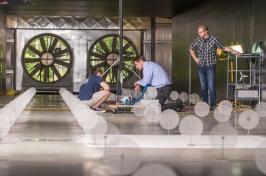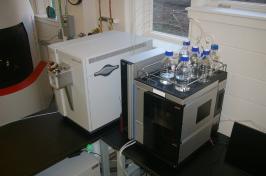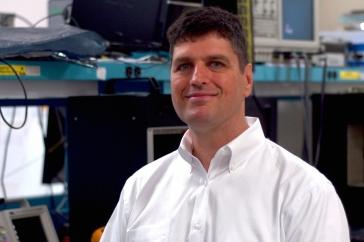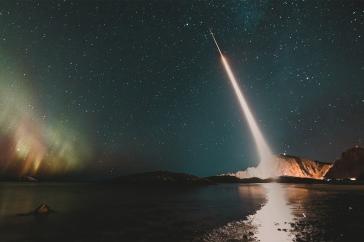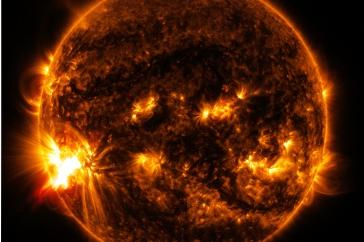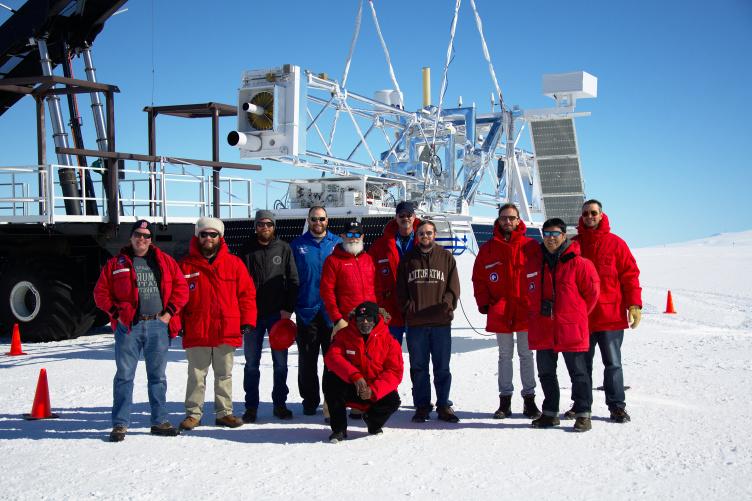
UNH physics professor Fabian Kislat, pictured here on the left, stands with team members in Antarctica with their telescope X-Calibur to learn about neutron stars.
Sometimes you have to go to the extreme reaches of the planet to study the most extreme phenomena in space.
Fabian Kislat, UNH professor of physics, recently spent two months in Antarctica with an international team of researchers to study neutron stars in our galaxy. After a series of weather delays out on the ice near McMurdo Station, Kislat and the team launched a scientific balloon that carried with it a telescope aimed at two bright neutron stars in the Milky Way — Vela X-1 and GX 301-2 — in a bid to learn more about these intriguing space objects.
A neutron star is very compact and dense, perhaps only seven miles wide but with more mass than our own sun and a very strong magnetic field. Sometimes, as is the case with Vela X-1 and GX 301-2, these neutron stars exist in a close orbit with another giant star that emits streams of charged particles similar to our solar wind. These particles accrete on the surface of the neutron stars because of their magnetic field — forces strong enough to draw out a near-constant flow of particles from the giant star.
“Some of the strongest magnetic fields in the universe are found around neutron stars — something like 12 orders of magnitude stronger than the Earth’s magnetic field,” Kislat explains. “They’re fascinating, and this research will help us to learn about how matter and radiation behave in these extreme magnetic fields,” he adds.
Neutron stars are somewhat difficult to study; they’re thousands of light years away from Earth and they’re small, so even the best telescopes can’t pick up more than a speck of light coming from them. They emit more X-rays than normal stars, though, which helps scientists differentiate between the two. These X-rays oscillate on various planes of direction, a phenomenon called polarization. The mission’s 27 ft., 3,500 lb. telescope, dubbed X-Calibur, was intended to measure the polarization of X-rays emitted from the two neutron stars to get a more accurate assessment of their geometry and how they behave.
"This research will help us to learn about how matter and radiation behave in these extreme magnetic fields."
The X-Calibur team, led by Henric Krawczynski from Washington University in St. Louis, chose Antarctica for the launch location due in large part to the polar winds that make a full revolution above the continent every 12 days or so. The team expected that the telescope would stay afloat to record data for at least a week or possibly even longer. This would give the device ample time to capture the data needed to determine the X-ray polarization from Vela X-1 and GX 301-2.
However, scientific field research doesn’t always go exactly as planned. The balloon kept X-Calibur aloft for three days before descending rapidly and landing hours away on the continent’s 12,000 ft. glacier, making retrieval of the telescope difficult. X-Calibur had sent its data to the team while it was in flight, so the team members were able to salvage the information collected during the mission without needing hands-on access to the telescope. No one is entirely sure what caused the rapid descent, but Kislat says he suspects there was a leak in the balloon. Despite the brevity of the flight, Kislat says they are likely to have enough data to draw some conclusions in the coming months.
The lead-up to the launch in Antarctica was a long time in the making; Kislat has been involved in various aspects of the X-Calibur mission since 2012 during his post-doctoral position at Washington University in St. Louis. From writing the software for the flight and for data acquisition to hardware integration, testing the detector, and developing data analysis methods, Kislat has worked on most aspects of the mission.
“What I like about the project itself is that it combines fundamental physics research and astrophysics with making and inventing the instruments to do this research,” he says. “It’s a very creative process in many ways.”
The team ran a few test flights from NASA’s Scientific Balloon Flight Facility in Fort Sumner, New Mexico, before heading to the South Pole. Conducting the final mission in Antarctica provided Kislat with a wholly unique experience. “It’s a place unlike any other in the world — not just because it’s cold and you’re on ice and there are no plants and very few animals,” Kislat says. “The scientific community that you find at McMurdo Station is very different than the scientists you might otherwise encounter elsewhere. There are people who return to work there each year because they love it, and they’re a tightly knit community,” he adds.
While it’s unclear if Kislat will return to Antarctica in the near future, he is currently working with the X-Calibur mission team to develop a new project proposal for a larger, more sensitive telescope that will have a mirror much larger in size. While a larger telescope will likely mean better data, there’s also the weight to consider. A scientific balloon can only carry so much weight and still achieve the necessary altitude to record data above the clouds, Kislat says. The engineering aspect of that project proposal and improvements to the X-ray detector are currently being discussed.
Funding for the X-Calibur project was provided by NASA and the McDonnell Center for the Space Sciences at Washington University in St. Louis.
-
Written By:
Rebecca Irelan | Institute for the Study of Earth, Oceans, and Space | rebecca.irelan@ngskmc-eis.net | 603-862-0990








































